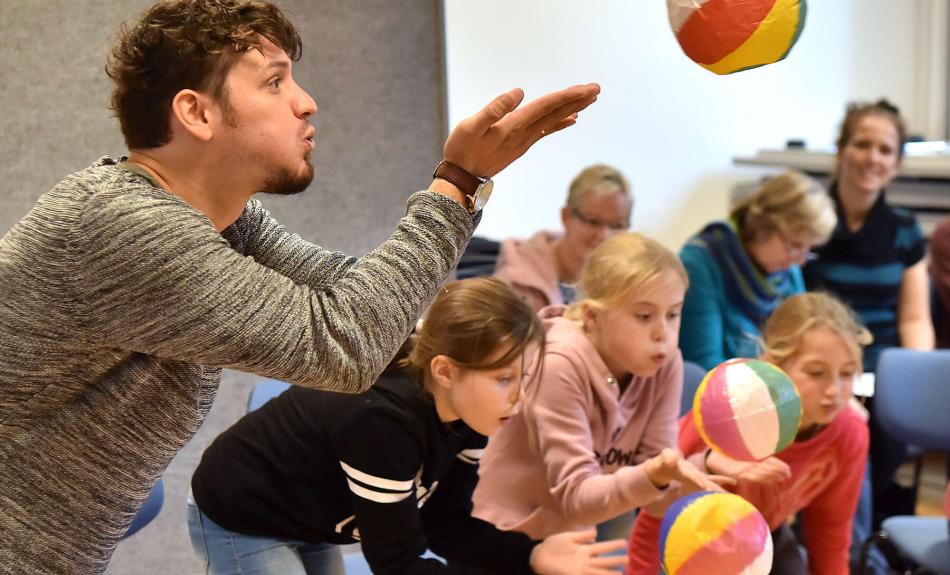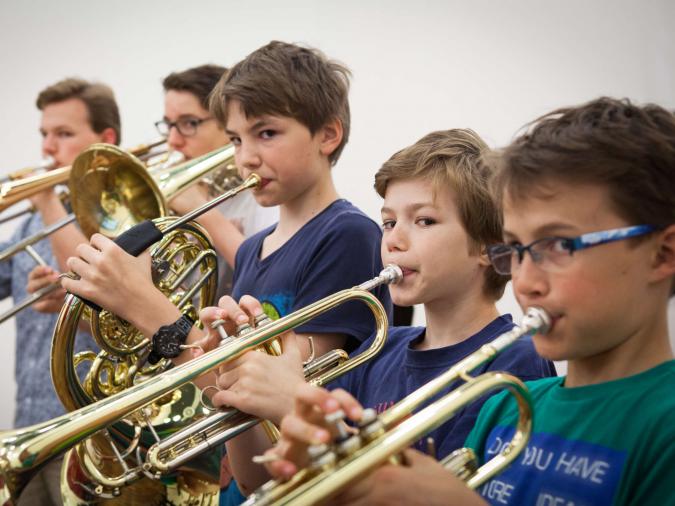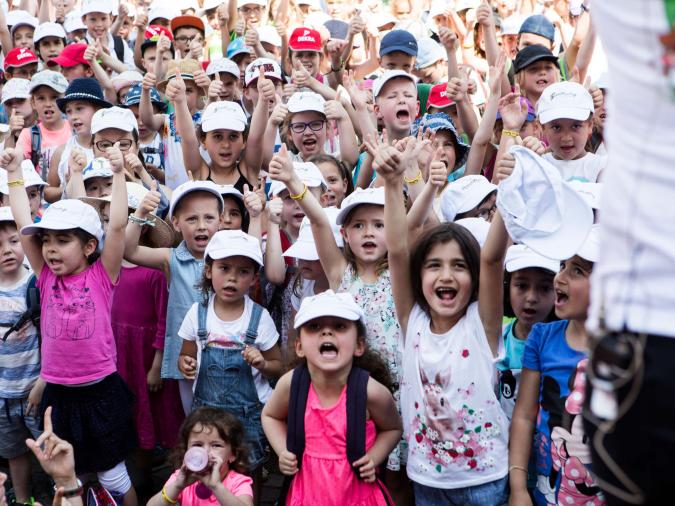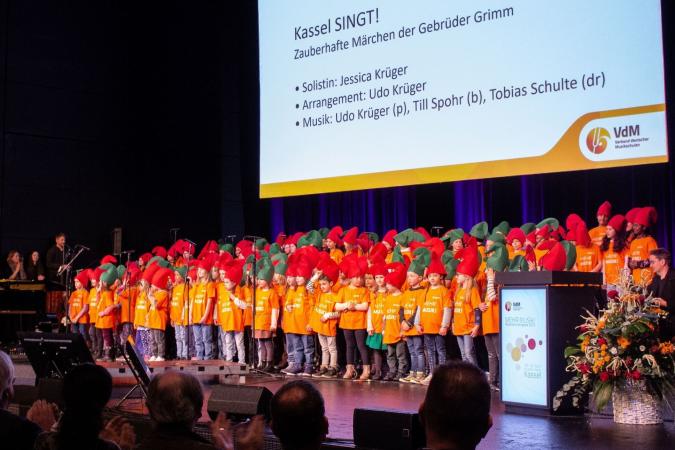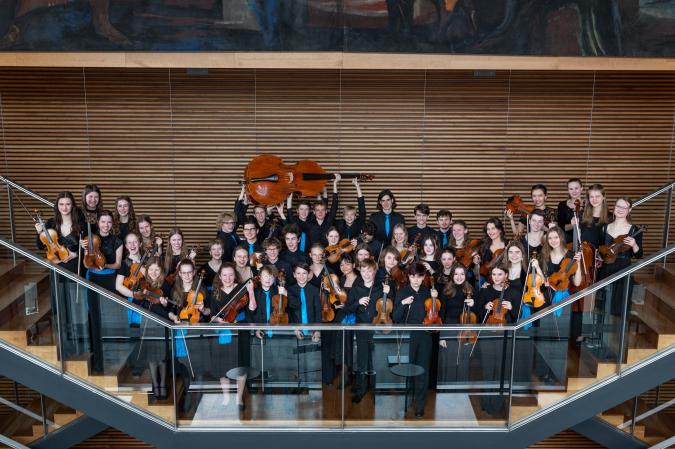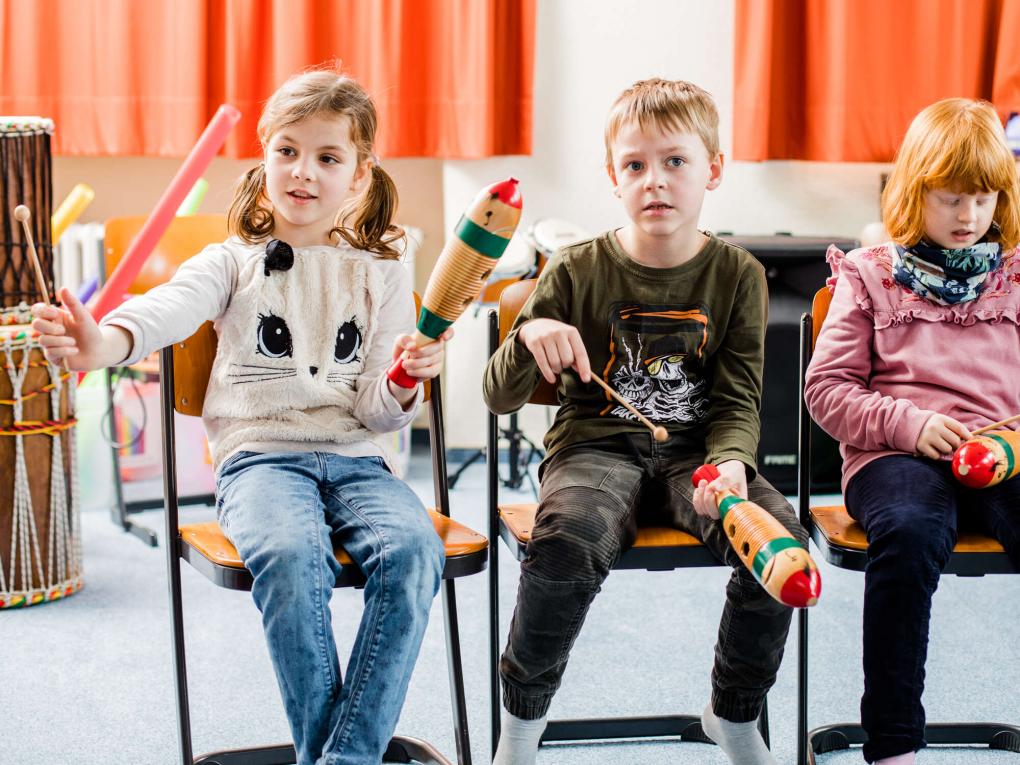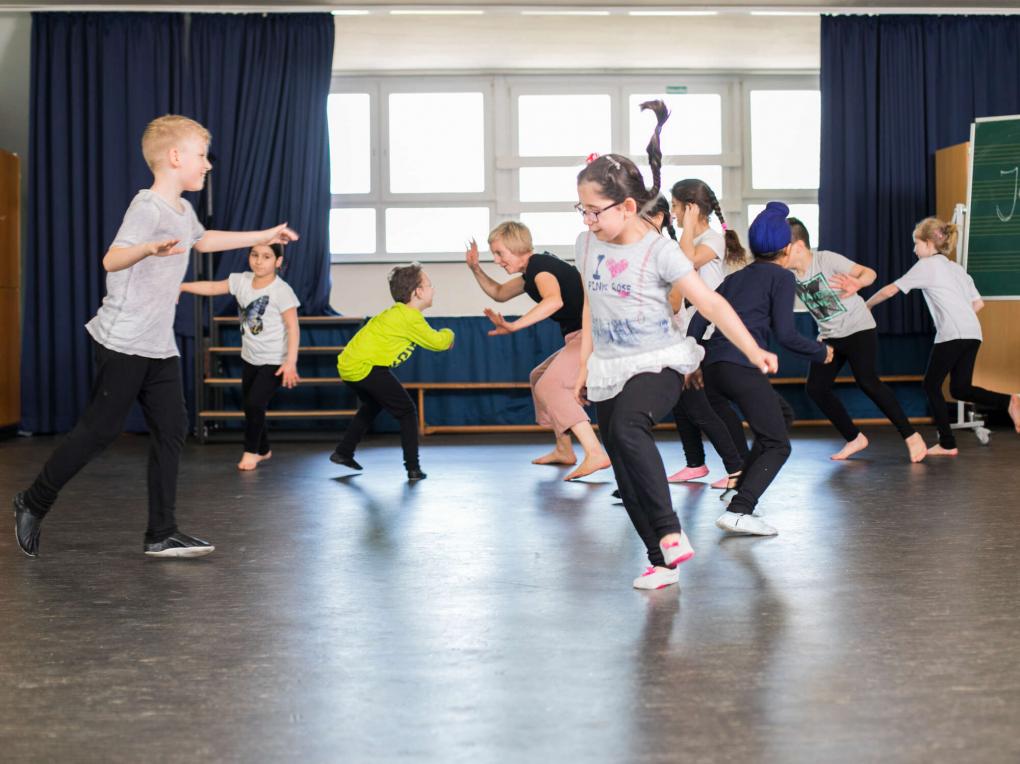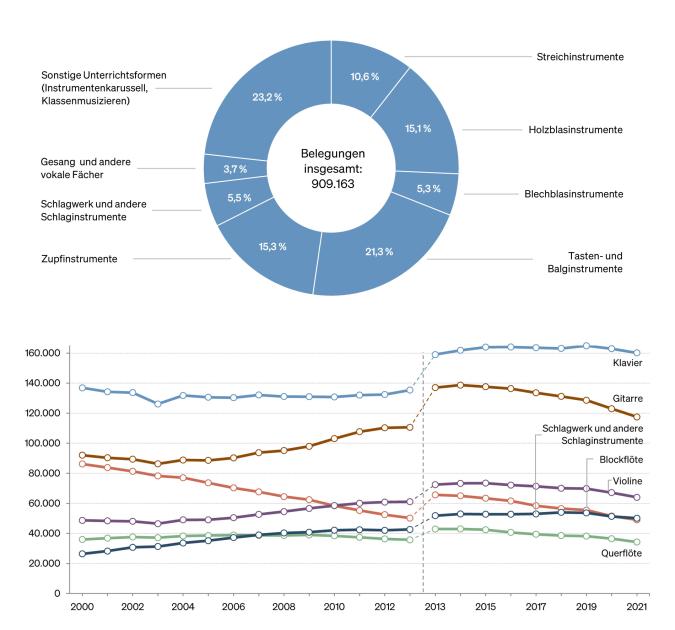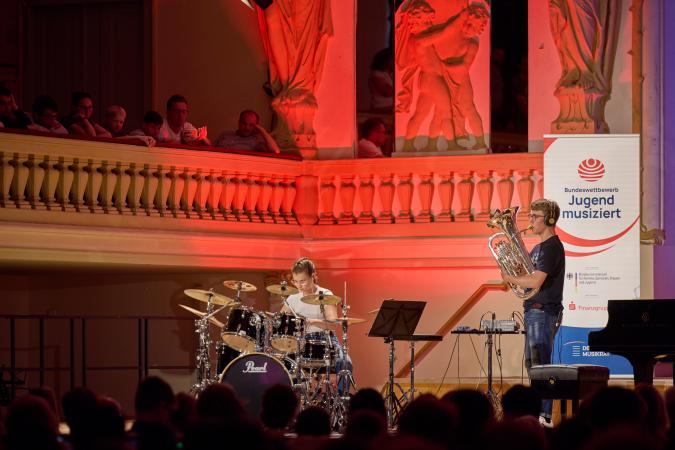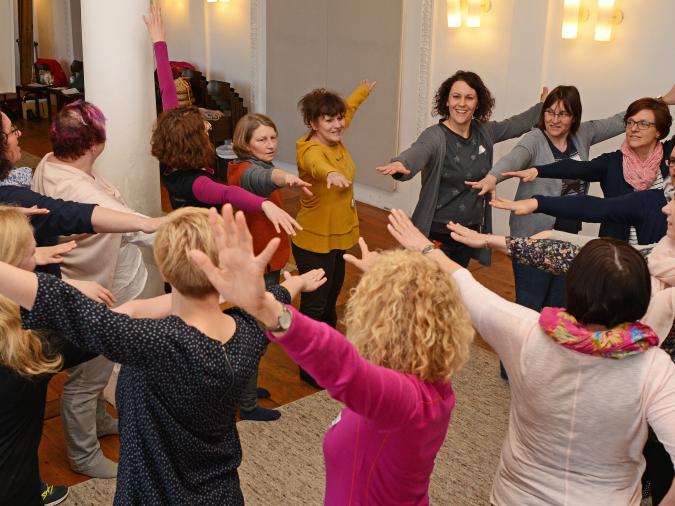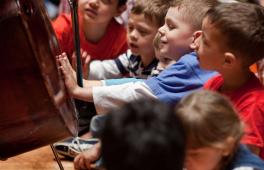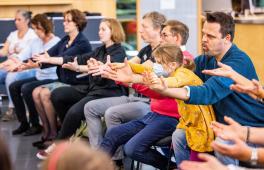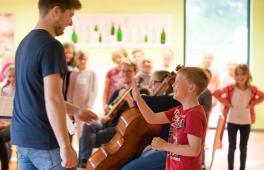Besides music instruction in Germany’s state school system, music education outside state schools is a field in its own right, with its own goals, tasks, structure and institutions. While music instruction in schools provides what amounts to mandatory general musical training for everyone, music education outside school is fundamentally voluntary. It also offers a wide range of individual options for taking an active part in music-making. Quite often the instruction centres on learning an instrument, but great importance is also attached to ensemble playing. Recent developments have cast doubt on the strict separation of music education inside and outside state schools. For one thing, many of Germany’s state schools offer instrument lessons in co-operation with public music schools and freelance teachers. For another, they also provide opportunities for playing music in a very wide range of ensembles. This was the case even more since 2003, when the federal government began to promote the establishment of all-day schools. Nonetheless, the interweaving of music education inside and outside the state school system has doubtless profited from the changes this entailed.
In principle, music education outside state schools should give people of all ages an opportunity to develop their musical abilities and skills according to their individual interests and to integrate them into cultural life. This calls for broad-based support with offerings that are both convenient to access and readily affordable. But especially interested and gifted children and young people must also be offered training at a high level, providing future professionals with crucial groundwork before they enter college.
The range of offerings available outside the German school system is broad and varied: public music schools can be found all across the country; private music schools have also emerged, as have freelance music teachers who offer private instruction on the open market; and day care centres for pre-school children are also gaining in importance. Moreover, 3.6 million people of all ages are involved in amateur music making in secular or church associations, which often provide lessons and support for their young members. [1] Many art schools for young people, such as those in the dance and new media sectors, also include musical components, offering interdisciplinary possibilities for creative work in courses, workshops or other projects. Music courses are offered specifically for adults and families at adult and family education centres. And finally, more than 300 youth orchestras have joined together in Jeunesses Musicales Deutschland, providing many incentives for ensemble playing in their initiatives and projects.
There is a broad consensus in German society on the value of music education outside the school system, since the importance of its role in personal growth and cultural involvement is basically beyond question. Its significance can be seen not least of all in the activities of theatres, concert halls and orchestras, which are increasingly addressing young audiences. Special inducements are provided by the programmes of the German Music Council and its member organisations. The council’s nationwide competition ‘Jugend musiziert’ (Youth Makes Music) has been an established feature of the music scene for almost 60 years. The competition is held at regional, state and national levels. More than 16,500 young people took part in the 2023 regional competitions, more than 7,000 in the state competitions and more than 2,200 in the 2023 national competition. Also worth mentioning are the national competitions ‘Jugend jazzt’ (Youth Plays Jazz) and ‘Jugend komponiert’ (Youth Composes). Last but not least, the German Music Council supports numerous music ensembles designed to foster up-and-coming young talent, such as the National Youth Orchestra of Germany and the state youth orchestras and choruses.
‘Pre-school and day care centres have a special opportunity to integrate music organically into the child’s everyday life.’
Nurseries and day care centres
Outside the home, children of pre-school age are most likely to encounter music in day care centres or nursery schools, where ‘training in music and art’ (‘musische Bildung’, to use the wording of the joint resolution of the Youth Ministers Conference and The Standing Conference of the Ministers of Education and Cultural Affairs) has become firmly anchored as an obligatory educational area in all of Germanys federal states. [2] Arts education in general, and music in particular, are central in varying degrees to the newest educational plans of Germany’s states. In addition to the dedicated field of music education, music can also be found as a cross-sectional task that can be fruitful in combinaton with other areas of education, such as language, cognition, sense perception, body movements and emotions. The core aim is to appeal to a child’s senses and emotions as well as fostering creativity and imagination. [3] Pre-school and day care centres have a special opportunity to integrate music organically into the child’s everyday life.
Accordingly, music is also meant to play a role at vocational colleges, where early education workers are trained, and at institutions of higher learning, which have begun to offer fields of study in this area, particularly since singing is a preferred activity in kindergartens. [4] As a result, music is usually included in the curricula of Germany’s states as an educational topic. It is treated as a subordinate field of study under a name such as ‘Professional Design of Social Work in Fields of Education’, or something similar. Usually, the number of units devoted to music is left open. [5] Viewed as a whole, training in music often fails to meet the qualification standards desired by the responsible institutions.
The importance of cultural education in early childhood and the deficiencies of music education in kindergartens have by now entered public awareness on many levels. This is apparent in the state educational plans cited above, in a series of projects aimed at establishing music in day care centres, and in appeals and position papers issued by professional associations and political bodies. [6] There has also been an increase in attempts to counter the dearth of musical stimuli in day care centres through continuing education projects for child care workers. A study on the co-operation between educators and musicians indicates a negative self-image of educators regarding their musical competences and their need for basic knowledge and practical skills. [7] This is one reason why foundations often become involved in fostering music at child care institutions. Recently some pre-school facilities have established themselves as ‘music kindergartens’. Some are also accompanied with research or concept development projects of the sort that Daniel Barenboim has introduced in Berlin’s Musik Kindergarten and in the MusikKinderGartenWeimar. Germany’s professional associations have likewise displayed great commitment to cultural education in early childhood.
Teachers from music schools or freelance music teachers often come to the kindergartens to teach. The framework conditions do not always allow this. Nevertheless, around one in twelve day care centres for children co-operate with a public music school. [8]
Public music schools
Public music schools play a key role among the providers of music education outside the state school system. As non-profit institutions, they perform educational, cultural, socio-political and youth-oriented tasks and have become permanent fixtures in Germany’s educational landscape.
Today 934 public music schools are members of the Association of German Music Schools (Verband deutscher Musikschulen, or VdM). [9] The central values of the VdM are to enable everyone to participate in music, to provide continuity and common educational experiences, to secure the organisational structure of the course offerings, to take part in social developments and to promote variety in musical culture. [10] Many public music schools offer instruction at various branch locations. At the end of 2019 roughly 21,000 locations were registered in Germany. On average, the schools are just under five kilometres apart and thus provide basic services, especially in rural regions, although the distance in sparsely populated areas is almost twice as great as the average at around nine kilometres. [11] (see Fig. 1).
Schools seeking to join the VdM must fulfil numerous quality criteria. This means that, for the state and for parents, membership guarantees a certain level of expertise. Teachers must have studied music education or have a comparable level of qualification, and school directors must have a degree in music. The VdM develops curricula, hosts continuing education programmes and congresses, and advises the schools in its membership. A number of the schools have developed additional quality assurance programmes.
In the past, public music schools have often proved open to new subjects and have kept abreast of developments in society. For instance, work during the final two pre-school years in what is called ‘early music education’ (‘Musikalische Früherziehung’) has become a set part of the schools’ offerings, as has the teaching of younger children and their caregivers. Since the 1990s, the VdM has also devoted more attention to adult beginners and people returning to music after a long absence. Today some 11 per cent of those enrolled at public music schools are 19 years or older (see Fig. 2). Demographic changes have also led to a greater focus on music education for seniors. At present 2.4 per cent of the VdM’s clientele are above the age of 60. Standard publications expressly emphasise the importance of a sufficient number of qualified offerings in this area. [12]
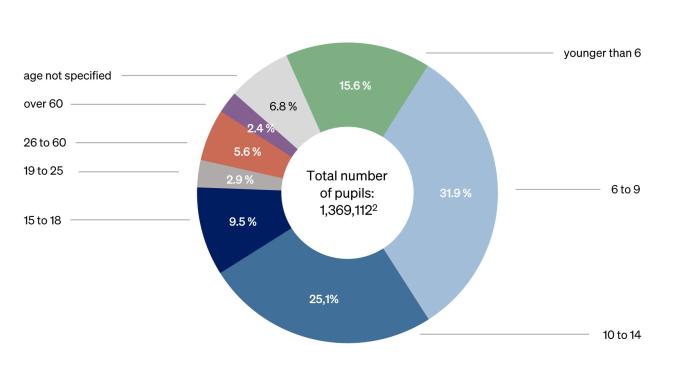
Since the early 1980s the VdM has also made a concerted effort to integrate children of immigrants. From 2006 to 2010 the association, faced with population changes, has launched a project called ‘Musikalische Bildung von Anfang an’ (Music Education from the Very Beginning), which deals with concepts of intercultural music education and addresses families from differing cultural, linguistic and social backgrounds. More than half of the music schools also offer instruction for the disabled. The VdM runs its own continuing education programme to train music teachers in this area. Finally, the music schools of the VdM have initiated many offerings in connection with refugees. [13] After the number of refugees and asylum seekers in Germany skyrocketed in 2015 and 2016, this once again prompted the VdM to take a stand. [14] As a result, numerous programmes for refugees were created at VdM music schools. After the outbreak of the Ukraine war, the VdM declared its solidarity with Ukraine. The music schools supported affected children, young people and adults with programmes and activities. [15] Over two thirds of the music schools also offer lessons for people with disabilities. To this end, the association itself organises the BLIMBLAM course, an in-service training course for music school teachers (see also the article by Irmgard Merkt ‘Wege in ein inklusives Musikleben’). Finally, it has recently been working intensively on protection concepts against abuse of power to make music schools safe places, especially regarding sexual abuse; it published a working aid and a collection of materials in 2023. [16]
The variety of musical genres taught at music schools has constantly grown. Popular music has long been a regular part of music school curricula. Special courses of study at university level offer degrees in teaching popular music. In addition to instruments such as the electric guitar, bass, saxophone and keyboards, schools also have ensembles playing rock, pop or jazz. Schools in rural areas will, as a matter of course, form ensembles or offer instruction in instruments particular to folk music. Today instruments native to the folk traditions of other countries, such as the Turkish bağlama, can also be studied at many music schools.
Structure
For public music schools, the VdM has developed a compulsory structural plan, which was last updated in April 2023. [17] The plan divides studies into four levels: elementary/basic, lower, middle and advanced. The elementary/basic level, which has its own educational plan, [18] presents fundamental instruction that is not only meaningful in its own right, but can also serve as the basis for later specialisation. It is noteworthy for its broad and diverse range of offerings: songs and vocal improvisation cover the area of singing; the instrumental category is represented by free and structured playing of various instruments, usually small percussion or what are called ‘Orff instruments’, named after the German composer and music educator Carl Orff; and the category of body movement includes dance, improvisational movement and body percussion. Closely interlinked with these categories are perception and experience, which range from stimulating the senses and listening to highly diverse pieces of music, to experiencing instruments that children might later learn to play. There is also a place in the programme for thinking about music, e.g. sharing musical impressions or discussing musical structures and notation. Finally, music is linked to other forms of expression, such as theatrical scenes, rhythmic declamation, visualising music through pictures or building instruments. According to the educational plan, instrument lessons take place on the lower, middle and advanced levels. In addition to individual lessons, the lower level in particular also provides for group or classroom instruction.
According to estimates from the VdM, nearly 57 per cent of all music schools offer a ‘college preparatory course’ for pupils who want to study music at the university level. This programme offers classes in the pupil’s primary instrument as well as instruction in a second instrument and preparation for the aptitude test in music theory and ear training. On average, a quarter of first-semester music students at university have completed such a course of study. In addition to the levels of instruction, the VdM’s structural plan also includes compulsory ensemble work and complementary subjects. The VdM considers ensemble work in particular to be an indispensable mainstay of public music schools, which often distinguishes them from private instruction. In 2021, each music school offered an average of around 25 hours of ensemble lessons per week, which were attended by 210 pupils. It should be born in mind that the coronavirus pandemic also restricted the work of ensembles in particular, which explains the decline in student numbers compared to previous years. Music schools also offer a broad spectrum of complementary subjects, such as ear training, music theory, or music and movement. The curriculum is rounded off with projects and special events. On average, each of the VdM music schools organised around 21 events per year in 2021; the contact restrictions in the wake of the pandemic must also be considered regarding this figure. Finally, the structural plan also calls for joint projects with other educational bodies in the municipal landscape.
Co-operative programmes
As in day care centres, co-operative programmes between music schools and state schools have increased in overall importance, if only because of the growing amount of time pupils now spend at school. According to figures from the VdM, roughly one in every three co-operative programmes is linked to a primary school, with the number reaching 4,100 at present, or even more in connection with kindergartens and day care centres. More than 75 per cent of music schools in the VdM thus work together with primary schools. Co-operative programmes with grammar schools are now maintained by 42 per cent of the VdM’s members, just over 20 per cent each co-operate with comprehensive schools and special schools. Co-operations with public music schools largely centre on the elementary/basic level, classroom instruction and various projects at all-day schools. At the elementary/basic level, especially new models of co-operation with primary schools have opened up fresh perspectives. One particularly vigorous co-operation is the so-called ‘JeKits’ programme (short for ‘Jedem Kind Instrumente, Tanzen, Singen’, or ‘Instruments, Dancing and Singing for Every Child’). The aim is to enable every primary school student to learn to express himself or herself in music, regardless of the financial means of the parents. The programme was initiated in North Rhine-Westphalia as part of the Ruhr area’s year as European Capital of Culture in 2010, when it was called ‘JeKi’ (‘Jedem Kind ein Instrument’, or ‘An Instrument for Every Child’) and was financed with public and foundation funds. Since the 2015-16 academic year each participating school chooses one of three main points of emphasis: singing, dancing or the playing of instruments. In the first year, group instruction in music or dance is compulsory in every class-room. The second up to the fourth year then offers lessons in the chosen form and participation in a related ensemble.
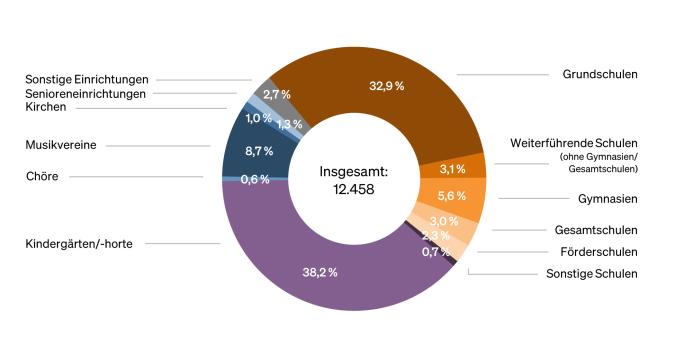
In the meantime, similar programmes have been adopted, with regional variations, by various communities and states, and group instruction in primary schools seems to have become a new field of activity for both music school and freelance music teachers. Besides JeKi in Hamburg, Hessen and Saxony, other programmes focusing on instrument instruction or singing also exist in primary schools.
The subsidised development of all-day schools in Germany has resulted in new organisational forms, tasks and student groups for music schools. Framework agreements between the VdM and the relevant state ministries are aimed at ensuring the quality of elective music courses at all-day schools and establishing VdM member schools as preferred partners in providing them. [19] This kind of co-operation is especially suited for musical ensembles, complementary courses, classes in elementary music-making and special projects. Besides permanent co-operations, public music schools are also intent on networking with other municipal institutions, such as libraries, museums, churches, youth centres and theatres.
Students and teachers
Nearly 1.4 million pupils currently attend Germany’s public music schools, including about two-thirds between the ages of six and 18 (see Fig. 2). A significant percentage also falls on those under six years of age (nearly 16 per cent) who take advantage of the many offerings in early music education. Roughly 10 per cent of the pupils are adults.
The instruments taught most frequently at Germany’s public music schools are, in descending order, piano, guitar, violin, percussion, recorder, and flute (see Fig. 4). Meanwhile more than 45,000 children in state schools take part in wind classes conducted via music schools, and about 16,000 in string classes. In addition, more than 21,000 children attend chorus and band classes. Over 13,700 play in percussion classes, just over 9,400 in plucking classes and almost 5,500 in band classes. More than 1,400 take part in class lessons on keyboard instruments. An overall increase in class lessons can be observed up to 2019, from then onwards the numbers are slightly declining; in some places, coronavirus may have hindered the establishment of such classes.
About 37,000 trained teachers teach at Germany’s public music schools, including roughly 54 per cent on permanent contracts and another 46 per cent as freelancers on a pro rata basis. Almost 13 per cent of those on permanent contracts are employed full-time. This means that the great majority work part-time. However, the absolute number of public music school teachers is probably slightly lower, as those who teach at more than one school will appear multiple times in the statistics.
Under VdM guidelines, teachers and directors at music schools are, for the most part, supposed to be officially employed by the school’s financing entity, and thus subject to the wage and salary agreements applicable to civil servants. In 2021 the per centage of teachers paid in this way varied from one federal state to the next between almost 11 per cent (Berlin) and over 88 per cent (Bavaria), with a nationwide average of just over 42 per cent. 12 per cent are employed at a different wage scale. Considering that between 80 and 90 per cent of teachers employed at music schools work part-time, it is safe to assume that many of them have second jobs, sometimes at other music schools, in order to secure their livelihood. In this context, a judgement by the Federal Social Court in the summer of 2022 raised eyebrows when it ruled that a freelancer at a music school was not self-employed with the freely organised tasks and working hours that are characteristic of this type of work and found that they were dependent employees who were subject to directives. [20]
Financing
In legal terms, the operation of facilities for music education outside the state school system is a voluntary expense of the public sector. On average nearly 60 per cent of the costs incurred by public music schools is paid from the public purse. The largest portion is provided by local authorities, while the portion borne by state governments varies widely from state to state, ranging in the non-city states from 4 per cent to more than 14 per cent. A few states have legally binding guidelines for the accreditation and funding of music schools, so that state funding is linked to VdM criteria.
More than 60 per cent of VdM schools are operated by governments at the municipal level. A good third is organised as a non-profit association but still receive substantial public funding. The overall budget for VdM music schools most recently amounted to roughly €1 billion. Nearly 37 per cent of the costs were covered by tuition fees. These in turn vary widely. There are also clear differences in the average values for the various federal states. The average monthly fees for a 45-minute one-to-one instrumental lesson are between €90 and €100 in Bavaria, Hamburg, Hesse, Lower Saxony and Schleswig-Holstein. In Bremen, North Rhine-Westphalia, Rhineland-Palatinate and Saarland, the average is around €80, in Berlin, Mecklenburg-Western Pomerania and Saxony a good €60 and in Brandenburg and Thuringia around €55. At an average of €49.50 per month for a single 45-minute lesson per week, the fees in Saxony-Anhalt are at the lower end, while Baden-Württemberg has the highest figure at €101.25. According to the VdM membership criteria, there must be an official schedule of fees that allows for discounts for socially disadvantaged pupils.
Private music schools
In addition to publicly funded music schools, Germany also has a very wide range of private or independent music schools. These include both large companies and franchise operations, some of which use their own teaching materials. Some music shops also offer instruction on various instruments. Conversely, some independent music schools can also offer instruments and instrument services. Finally, there are private music teachers who run small schools at their own initiative, usually with a single location and sometimes focused on a specific genre (e.g. a genre of popular music) or a specific instrument. Such schools thus differ markedly in structure from public music schools, for only in Bavaria is the term ‘music school’ protected and subject to particular stipulations. Since privately run music schools must be economically viable to survive, they must take in more money than they spend. This is in principle true even when small subsidies are provided by a local authority, perhaps because it does not operate a music school of its own.
The German Association of Free Music Schools (Bundesverband der Freien Musikschulen, or bdfm) is a consortium of free music schools with agreed standards for certified membership. Criteria concern contractual agreements, teaching space, involvement in public music life and teacher qualifications, though here a standard music degree is not mandatory. In the case of lateral entry from another qualification, the teaching qualification is checked based on a teaching test. From 2020, the bdfm will delegate the examination for the teaching qualification to the private vocational schools for rock, pop and jazz in Hanover and Giessen. There are state groups or associations of the bdfm in many German states, with a total of roughly 450 schools and 6,300 teachers at the time being. In 2016, around 127,000 pupils were taught by around 6,300 teachers at the 340 member schools of the bdfm. These figures are estimates based on a voluntary survey conducted by the bdfm. [21] Although the response rate was only 36 per cent, the findings shed a certain light on the membership of the bdfm. Like the VdM schools, a large number of independent music schools co-operate with state schools or other institutions, such as day care centres, music clubs and church congregations, as well as choruses, senior citizen facilities and adult education centres, thereby incorporating an additional 31,000 pupils into their teaching activities at that time.
Regarding the age groups of their pupils, independent music schools differ considerably from their public counterparts. People 26 years and older make up only 7 per cent of pupils at the VdM’s member schools, but more than twice that number at music schools in the bdfm (18 per cent). The bdfm lists the most popular instruments only by group. Heading the list by a small margin are plucked instruments, followed by keyboard instruments. Ranked third on the popularity scale is elementary music-making, clearly ahead of percussion, woodwind and string instruments as well as voice and brass instruments (see Fig. 5). These figures sometimes differ markedly from those of the VdM, especially as regards the popularity of string instruments. In addition to instrument lessons, the bdfm music schools also have such extra offerings as band, music theory, chamber music, chorus and orchestra, as well as instruction for senior citizens and disabled people.
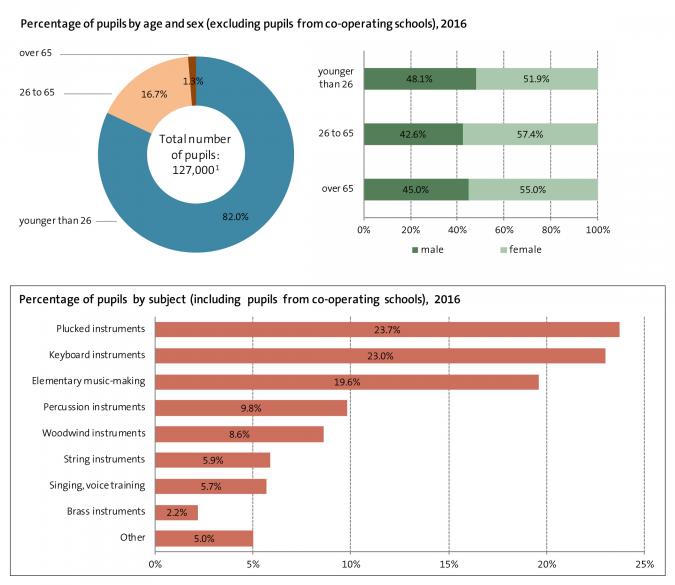
Compared to VdM music schools, the members of the bdfm have far fewer teachers on permanent contracts. They are found in only some 7 per cent of the schools, whereas more than 90 per cent employ teachers exclusively on a pro rata basis. Of the latter, a good 40 per cent earn up to €18 per lesson, another 40 per cent between €18 and €24, and every sixth pro rata teacher more than €24. The fees earned for group instruction and elementary music-making are higher.
The great majority of bdfm music schools are either one-person businesses (68.3 per cent) or organised as non-profit limited liability companies (9.8 per cent), civil-law partnerships (6.5 per cent), non-profit associations (5.7 per cent) or, more rarely, for-profit companies (3.3 per cent) or for-profit associations (1 per cent). All in all, 15.5 per cent of the member schools have non-profit status. Only about a quarter of bdfm schools receive subsidies from the public purse.
Freelance music teachers
Freelance music teachers have always been a mainstay of music education outside Germany’s state school system. The very fact that in 2019 a good sixth of children and young people in the ‘Jugend musiziert’ (Youth Makes Music) competition on the national level were taught by private music teachers unconnected with music schools bears witness in some cases to their high qualifications. [22] They teach at all levels, from beginners to pupils preparing for university studies, and in some cases, they even work with professional musicians. Some of them are able to adapt to pupils’scheduling needs or their desire for sporadic tuition. Often, they are also able to respond to a student’s need for tuition at home. By joining together, freelance music teachers can offer an enlarged range of tuition, such as lessons in ensemble playing. Sometimes schools or church congregations organise private tuition and provide the necessary rooms for it to take place. In general, private teachers contribute to decentralised and customer-focused music tuition. It should also be borne in mind that not every pupil can find a place in public music schools, which could have accommodated 70,000 additional pupils in 2020 if the necessary resources had been available. [23]
Freelance music teachers often put together patchwork careers made up of private lessons, fee-based teaching at music schools, concert appearances and the like. If they can prove that most of their income comes from freelance work in music, they may also apply for admission to Germany’s social insurance scheme for artists (Künstlersozialkasse, KSK). The KSK pays half of a member’s social welfare contributions, an amount normally paid by the employer in Germany. Since private music teaching does not necessarily require formal qualifications, many freelance music teachers join the German Musicians’ Association (Deutscher Ton-künstlerverband, DTKV), which is in turn divided into statewide organisations. Membership requires proof of professional qualifications and, as such, serves as a seal of commendation. The DTKV negotiates framework contracts with insurance companies, organises conferences and courses, and functions as an advocate for its members in the political arena. For example, its governing board and state subsidiaries are taking part in the debates on all-day schools.
The financial circumstances of freelance music teachers can be quite precarious. Some of them have other professional or private priorities that restrict their activities to a relatively small number of pupils. But many are intent on expanding the number of lessons they give. Some succeed in establishing a good reputation in their catchment area, allowing them to attract regular pupils and achieve earnings comparable to those of permanently employed music school teachers. But most earn far less than their staff colleagues. According to a survey of music school teachers, conducted for the third time by the German trade union ver.di in 2017, lesson fees represent the sole or main source of household income for nearly a third of all freelance teachers employed at music schools. [24]
Amateur music-making
Across Germany there are a good 21,000 secular amateur choirs and nearly about as many instrumental ensembles organised in associations. [25] Numerous music associations independently organise and run instruction for their young members. Special courses exist that can lead to a license as a training supervisor at various levels. The National Union of German Music Associations (Bundesvereinigung Deutscher Musikverbände, BDMV), which in turn is a member of the Federal Music Association Choir & Orchestra founded in 2019, provides guidelines for the training of musicians (among other things) and compiles literature lists for competitions. Its youth organisation, the Young German Wind Players (Deutsche Bläserjugend), has 350,000 children and young people up to the age of 27 in its wind ensembles and marching bands. Instrument training is offered by its own members, freelance teachers or music schools. The examinations (referred to as D1, D2 and D3) lead to bronze, silver or gold medals and include recital pieces at pre-defined levels of difficulty, various exercises and written assignments related to music theory. Similar courses and examinations are offered by the Federation of German Mandolin and Guitar Players (Bund Deutscher Zupfmusiker, BDZ), the German Zither Music Federation (Deutscher Zithermusik-Bund, DZB) and the German Harmonica Association (Deutscher Harmonika-Verband, DHV). Finally, amateur music associations train select pupils from the age of 15 to be so-called ‘music mentors’ for youth work in their associations. Amateur music associations often enter into co-operative training arrangements with federal and state music academies, which offer a broad spectrum of courses all over the country.
Those interested in musical activities and developing their musical skills and abilities can also find a variety of possibilities in church congregations. Directing choirs and ensembles has been the responsibility of church musicians since time immemorial and forms an essential part of their training. Here pastoral work interlocks with music teaching and artistic aspects. There are almost 34,000 church choirs in the country, including numerous children’s and youth choirs, all of which are essential to church worship and parish life. In 2021, a total of around 28,000 choirs were organised in the Catholic and Protestant churches. [26] Often there are also open singing circles for seniors and, finally, church instrumental ensembles. The brass choirs associated with the Lutheran church enjoy a particularly rich tradition. In 2021, a total of more than 674,000 people in Germany sang or played in church ensembles, most of them in choirs. Children and young people account for more than one-sixth of the members of church choirs and instrumental groups. Many churches also organise special educational courses on music.
Adult education and family education centres
Besides music schools, Germany’s state-subsidised adult education centres (Volkshochschulen) can also be community providers of music instruction. These centres are mandated to offer courses of all kinds to adults. Rather than offering fields of study in the manner of a university, they provide various personalised forms of continuing education. For instance, participants can learn a language, receive an introduction to certain areas of computer use or make up part of a missing school degree or leaving certificate. People book the instruction, including in music, as a course for one semester or a pre-set number of lessons. Rather than being salaried employees, the teachers are paid on a pro rata basis.
In terms of music performance, the centres offer such things as group musicmaking and instrument lessons. The number of performance courses on offer each year has remained constant for years. In 2019 it was 13.400. The coronavirus pandemic cut the number in half in 2021. In 2021, the courses covered on average roughly 16 lessons and were attended by 5.6 pupils. In addition, prior to corona, about 450 to 500 music theory courses for more than twice as large groups were also offered at adult education centres. This number also dropped during the pandemic; around 320 music theory courses were offered in 2021. [27]
Finally, intergenerational opportunities in particular, such as parent-child groups, can be found at family education centres. These are basically similar to adult education centres. They are often run and/or funded by churches, associations or local governments and generally offer courses of limited duration. The courses cover a variety of subjects: health, parenting, life crisis management, continuing education in social pedagogy, but also fields of creativity. For instance, depending on the centre, one might find courses in dancing, guitar or groups for elementary music-making. Family education centres seek to support families with their course offerings and to contribute to their personal guidance and education. One clear indication of their social mission is that the courses are usually inexpensive. Thus, music plays a role in many of these institutions as an opportunity to develop an individual’s creative potential and to enrich family life.
General trends
Finally, the field of music education outside the state school system is affected by developments that characterise society as a whole. In particular, the recent effects of the coronavirus pandemic, digitalisation and the shortage of skilled workers should be mentioned here.
Since March 2020, the coronavirus pandemic has brought large parts of social life to a standstill. It is therefore not surprising that extracurricular music education has also been affected. Lessons at music schools and with independent teachers were temporarily cancelled or held digitally. The quality of the lessons suffered because of the inadequate auditory impression, which was due to the current technical conditions and the time delay with which signals were transmitted. This rendered it much more difficult, if not impossible, to make music together. With distance learning, music schools were at least able to provide their students with a regular weekly appointment in times of school closures. In addition, video and audio files were sent. Pupils made recordings of themselves and sent them to their teachers, whereas teachers created lesson videos, as was often the case for elementary music practice. There were also some benefits: for example, lesson videos made it possible to reach the children's families, and there was greater autonomy in the use of the programmes, as the videos could be watched at freely chosen times or even several times at home. [28] Ensembles in particular - whether at music schools or in the amateur sector - suffered from the restrictions and lost members; in many cases, rehearsals came to a complete standstill.
Especially in times of the pandemic, the possibilities of digital media for music education work have become apparent. However, these are not limited to teaching formats, but also include aspects of networking and communication as well as content-related dimensions. In a position paper published in 2021, the VdM called for a ‘digitalisation strategy by the federal, state and local governments for music schools in the municipal educational landscape’. [29] Even if face-to-face teaching continues to be seen as a key factor, it could be supported digitally. Video streaming, video tutorials, online lessons and cloud formats are mentioned in this context. Digitally supported communication between teachers, pupils, parents and administration is in line with the communication habits of those involved in the private and social sphere, but must also be designed in accordance with data protection requirements. [30] Digital tools such as apps for tuning or as a metronome have not only made their way into the classroom, but smartphones and tablets are also used for music production and as stand-alone musical instruments. [31]
Finally, the shortage of specialists is increasingly being recognised as a problem for music education outside the state school system. It is already foreseeable that the positions at public music schools that will become vacant due to retirement will hardly be filled with graduates of artistic-pedagogical degree programmes in the coming years. This will jeopardise the music schools' ability to fulfil their mission. In its Kassel Declaration of 2023, the VdM attributes this mainly to the lack of attractiveness of the job profile, points out that the pay scale for music school teachers has remained unchanged since 1987 and calls for a review of the pay scale structure. [32] In addition, demographic change is probably also partly responsible for this development. [33] It is to be feared that the qualification standards for music education will lose their binding nature. Moreover, as the proximity of programmes to residential areas and the occupancy rates are linked, [34] Germany could move further away from nationwide coverage than before.
Conclusion
Germany has a wide range of opportunities for all age groups in music education outside its state school system, from parent-child groups working with children as young as infants, to pre-school and schoolage instruction and programmes aimed specifically at adults, including the elderly. Private providers complement the course offerings of public institutions. Particularly in rural areas, the duties of music education outside the schools often fall to amateur music associations. Public and private music schools, with their respective standards, are nonetheless widespread throughout all the German states. In short, people in Germany have access to a wide-ranging network of options for musical activities and for acquiring and developing their individual skills and abilities. Current developments and challenges involve digitalisation as well as an increasing shortage of skilled workers.
Footnotes
- See the statistics Mitglieder in den Verbänden des instrumentalen und vokalen Amateurmusizierensof the German Music Information Centre (accessed on 17. January 2024).
- See Gemeinsamer Rahmen der Länder für die frühe Bildung in Kindertageseinrichtungen. Beschluss der Jugendministerkonferenz vom 13./14.05.2004 / Beschluss der Kultusministerkonferenz vom 03./04.06.2004, online at https://www.kmk.org/fileadmin/veroeffentlichungen_beschluesse/2004/2004_06_03-Fruehe-Bildung-Kindertageseinrichtungen.pdf (accessed on 18. January 2024).
- See the educational plans of the federal states of Germany for early education at day care centres, online at https://www.bildungsserver.de/Bildungsplaene-der-Bundeslaender-fuer-die-fruehe-Bildung-in-Kindertageseinrichtungen-2027-de.html (accessed on 18. January 2024).
- See Peter Brünger, ‘Singen im Kindergarten’, in: Andreas Lehmann-Wermser and Anne Niessen, eds., Aspekte des Singens. Ein Studienbuch (Augsburg, 2008), pp. 65-77.
- See Kultusministerkonferenz [Standing Conference of the Ministers of Education and Cultural Affairs], Rahmenlehrplan für die Fachschule für Sozialpädagogik. Beschluss der Kultusministerkonferenz vom 18.06.2020, online at https://www.kmk.org/fileadmin/Dateien/veroeffentlichungen_beschluesse/2020/2020_06_18-RVFS-RLP-Sozpaed.pdf (accessed on 3. December 2023).
- See Föderation musikpädagogischer Verbände Deutschlands, Positionspapier zur musikalischen Bildung(Trossingen, 2021) (accessed on 3. December 2023); Bundesvereinigung Kulturelle Kinder- und Jugendbildung e. V., ed., Spiel und Kunst von Anfang an. Kulturelle Bildung für junge und sehr junge Kinder. Positionen und Ziele (Remscheid and Berlin, 2016), (accessed on 3. December 2023).
- Lars Oberhaus and Alexis Kivi, ‘Musiker und Erzieherinnen in Kitas. Spannungsfelder ihrer Zusammenarbeit im Rahmen einer berufsbegleitenden Weiterbildung’, in Bernd Clausen and Susanne Dreßler, eds., Soziale Aspekte des Musiklernens (Münster et. al., 2018) pp. 207-220, esp. pp. 212 and 215, online at https://www.pedocs.de/volltexte/2020/20733/pdf/AMPF_2018_Band_39_Oberhaus_Kivi_Musiker_und_Erzieherinnen.pdf (accessed on 29. January 2024).
- 4,765 kindergartens/day nurseries co-operated with a public music school in the calendar year 2021. This corresponds to 12.3 per cent of the 58,500 daycare facilities reported by the Federal Statistical Office as of 1 March 2021. See Statistisches Bundesamt [Federal Statistical Office], Kinder und tätige Personen in Tageseinrichtungen und in öffentlich geförderter Tagespflege am 01.03.2021, online at https://www.destatis.de/DE/Themen/Gesellschaft-Umwelt/Soziales/Kindertagesbetreuung/Publikationen/Downloads-Kindertagesbetreuung/tageseinrichtungen-kindertagespflege-5225402217004.pdf (accessed on 2. December 2023); see the statistics Kooperationen von Musikschulen im VdM mit allgemeinbildenden Schulen und anderen Partnernof the German Music Information Centre, year of reference 2021, (accessed on 3. December 2023).
- All figures listed below regarding public music schools are taken from the statistics of the Association of German Music Schools (Verband deutscher Musikschulen, VdM), which updates and publishes them at regular intervals. See Verband deutscher Musikschulen, ed., Statistisches Jahrbuch der Musikschulen in Deutschland (Bonn, 2023).
- Verband deutscher Musikschulen [Association of German Music Schools], Grundsatzprogramm [2016], (accessed on 26 September 2018).
- See German Music Information Centre, Öffentliche Musikschulen in Deutschland. Infrastruktur und Nutzung öffentlicher Musikschulen im Verband deutscher Musikschulen (Bonn, 2022) pp. 13-14, (accessed on 3. December 2023).
- Verband deutscher Musikschulen [Association of German Music Schools], ed., Musik – Ein Leben lang! Grundlagen und Praxisbeispiele (Bonn, 2009); Theo Hartogh and Hans Hermann Wickel, Musizieren im Alter. Arbeitsfelder und Methoden (Mainz, 2008).
- See Verband deutscher Musikschulen [Association of German Music Schools], ed., Kulturelle Vielfalt in der Elementarstufe/Grundstufe (Bonn, 2010).
- See Robert Wagner, ‘Der Beitrag öffentlicher Musikschulen zur Integration von Geflüchteten und Asylsuchenden’, in Verband deutscher Musikschulen [Association of German Music Schools], ed., Spektrum Inklusion. Wir sind dabei! Wege zur Entwicklung inklusiver Musikschulen (Bonn, 2017), pp. 322–326. For the number of refugees and asylum seekers in 2015 and 2016, see Bundeszentrale für politische Bildung [Federal Agency for Civic Education], Asylanträge in Deutschland. Infografiken zu Asylanträgen und Asylsuchenden (Bonn, 2023), online at https://www.bpb.de/themen/migration-integration/zahlen-zu-asyl/265708/asylantraege-in-deutschland/#node-content-title-2 (accessed on 3. December 2023).
- See Solidarität mit der Ukraine. Aufruf des Verbandes deutscher Musikschulen zur Hilfe für die Ukraine und die Geflüchteten in Deutschland (Bonn, 2022), online at https://www.musikschulen.de/aktuelles/fluechtlinge/index.html (accessed on 3. December 2023).
- See Verband deutscher Musikschulen [Association of German Music Schools], ed., Musikschule: ein sicherer Ort! Arbeitshilfe und Materialsammlung zur Erstellung eines Schutzkonzeptes (Bonn, 2023).
- See Verband deutscher Musikschulen [Association of German Music Schools], Strukturplan des VdM. Die öffentliche Musikschule: Konzept, Aufbau und Struktur (Bonn, 2023), online at https://www.musikschulen.de/musikschulen/strukturplan/index.html (accessed on 19. January 2024).
- See Verband deutscher Musikschulen [Association of German Music Schools], ed., Bildungsplan Musik für die Elementarstufe / Grundstufe (Bonn, 2010); on the new edition see Michael Dartsch et.al., ‘Der neue Bildungsplan für frühe musikalische Bildung in und mit Musikschulen. Ein Beitrag zur Bewältigung aktueller gesellschaftlicher Herausforderungen?’, in üben & musizieren research, Sonderausgabe Artistic Citizenship, 2023, pp. 114-123, online at https://uebenundmusizieren.de/wp-content/uploads/sites/4/2023/08/8-Dartsch-et-al.pdf (accessed on 3. December 2023).
- See Verband deutscher Musikschulen [Association of German Music Schools], Rahmenvereinbarungen / Richtlinien der Länder, online at https://www.musikschulen.de/kooperationen/allgemeinbildende-schulen/rahmenvereinbarung-richtlinien/index.html (accessed on 19. January 2024).
- See Bundessozialgericht [Federal Social Court], BSG Az.: B 12 R 3/20, online at https://www.bsg.bund.de/SharedDocs/Downloads/DE/Entscheidungen/2022/2022_06_28_B_12_R_03_20_R.pdf?__blob=publicationFile&v=2 (accessed on 3. December 2023).
- For this and the following data about the bdfm see Bundesverband der Freien Musikschulen (bdmf), Statistik 2016 (accessed on 19. Januar 2019).
- See Verband deutscher Musikschulen [Association of German Music Schools], ed., Statistisches Jahrbuch der Musikschulen in Deutschland 2019 (Bonn, 2020) p. 27. Due to the coronavirus pandemic, no corresponding data was collected for 2020 and 2021, see Verband deutscher Musikschulen, Statistisches Jahrbuch 2021, p. 33.
- See Verband deutscher Musikschulen [Association of German Music Schools], Statistisches Jahrbuch 2021, p. 19.
- See Jürgen Simon, Einkommenssituation und Arbeitsbedingungen von Musikschullehrkräften und Privatmusiklehrern 2017. Ergebnisse der Umfrage der Fachgruppe Musik der ver.di von Juli 2017-September 2017, ed. ver.di | Vereinte Dienstleistungsgewerkschaft (Berlin, 2017), (accessed on 18. July 2018).
- See the statistics Mitglieder in den Verbänden des instrumentalen und vokalen Amateurmusizierens of the German Music Information Centre, years of reference 2019/20 (accessed on 19. January 2024).
- See the statistics Chor und Instrumentalgruppen in der evangelischen Kirche, year of reference 2021 as well as Chor und Instrumentalgruppen in der katholischen Kirche, year of reference 2022 of the German Music Information Centre (accessed on 19. January 2024).
- For the data on adult education centres here and below, see the statistics Musikangebote der Volkshochschulen, year of reference 2021 of the German Music Information Centre (accessed on 4. Dezember 2023) [the statistics will be updated, Anm. d. Red.])
- See Michael Dartsch, ‘Auf neuen Wegen. Elementare Musikpraxis im Zeichen von Digitalisierung und Kontaktbeschränkung’, in üben & musizieren, 38, 2021, 2, pp. 14–19.
- Verband deutscher Musikschulen [Association of German Music Schools], Musikschulen dürfen digital nicht abgehängt werden – Musikalische Kinder- und Jugendbildung in Gefahr! (n.p., 2021) p. 3.
- See Michael Dartsch, ‘Auf neuen Wegen. Elementare Musikpraxis im Zeichen von Digitalisierung und –Kontaktbeschränkung’, in üben & musizieren 2/2021, pp. 14-19, esp. pp. 16 and 18.
- See Rainer Kotzian, ‘Digitale Medien’, in Michael Dartsch et. al., eds. EMP kompakt. Kompendium der Elementaren Musikpädagogik, Vol. 1, Lexikon (Innsbruck et. al., 2020) pp. 70-75.
- See Verband deutscher Musikschulen [Association of German Music Schools], Kasseler Erklärung der Bundesversammlung des VdM. Bedrohlichem Mangel an Fachkräften entgegenwirken! (Kassel, 2023), (accessed on 19. January 2024).
- See Bundesministerium für Wirtschaft und Klimaschutz [Federal Ministry for Economic Affairs and Climate Protection], Fachkräfte für Deutschland (n.y.) Online unter: https://www.bmwk.de/Redaktion/DE/Dossier/fachkraeftesicherung.html (accessed on 3. December 2023).
- See German Music Information Centre, Öffentliche Musikschulen in Deutschland (2022) pp. 17-18.
